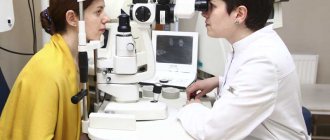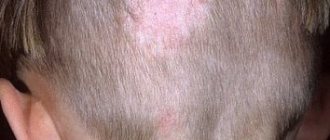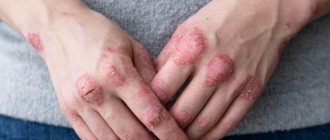- Acne treatment
- Rosacea Treatment
- Treatment of demodicosis
“ Subcutaneous mite ” sounds very unpleasant, and many may think that anyone can get this parasite, but “but not me.”
In fact, demodicosis - this is the name given to damage to hair and skin areas by a microscopic mite - is far from a rare phenomenon. And some cosmetic procedures can provoke an exacerbation.
Scientific fact: human skin can be parasitized by 2 types of Demodex , which feed on dead skin cells and live on the skin and hair follicles, including eyelashes and eyebrows:
- brevis;
- folliculorum.
As a result of their activity, a person feels itchy skin, redness, peeling appear, and the skin becomes rougher. If measures are not taken, all these unpleasant symptoms can develop into crusts and inflammatory elements.
100% of people over 18 years of age have demodex mites
Recently, a research article published in the Public Online Scientific Library PLOS ONE (USA) [2] confirmed: “100% of people over 18 years of age have demodex mites”!
In the past, the prevalence and diversity of Demodex mites were poorly understood because... The traditional sampling method was used: "microscopic analysis", in which only 12–25% of adults were found to have Demodex mites on their faces.
This study used a new molecular method to assess the prevalence of Demodex mites in humans by collecting DNA from people's faces. The results showed that the face of every adult in the experiment had Demodex mite DNA, indicating that Demodex mites are indeed present on the facial skin of every person.
Diagnostics
The symptoms of the disease have a number of similarities with other skin pathologies, so the most reliable method of confirming it is mite detection test
To do this, a scraping is taken from suspicious areas using a scalpel.
Before the study, patients are asked not to use soaps, gels or shampoos when caring for their face and body.
The biopsy is placed under glass and then examined in the laboratory under a microscope.
The main manifestations of demodicosis in humans
– the skin becomes constantly oily, greasiness increases, – pores expand, – redness in the central part of the facial skin, – the general condition of the skin is unhealthy, the complexion is earthy-gray, – skin inflammations appear: acne, acne, pustules, papules, pustules, blackheads , acne, sores, – itching, – facial skin becomes flabby, lumpy – facial expressions become difficult, – puffiness of the face and nose occurs, – hair and eyelashes fall out (if the hair is damaged).
The rapid progression of demodicosis is dangerous due to the appearance of difficult-to-remove cosmetic defects: scars, potholes, scars.
Untreated demodicosis can lead to an enlarged nose (rhinophyma), inflamed eyes (blepharitis), eyelashes to fall out, and early baldness.
Signs of illness
In its manifestations, damage to the subcutaneous mite is very similar to rosacea or acne. Peeling of the skin and its redness are noted, itching may occur, constant or worsening after using tonics or washing with cold water. Sometimes there is a combination of demodicosis caused by subcutaneous mites and the above-mentioned skin diseases. And this is not surprising, because the occurrence of demodicosis is influenced by negative changes in the skin. Thus, both acne vulgaris and rosacea weaken the skin’s natural defenses. When affected by skin mites, the following parts of the face are most often affected: eyelids, forehead, chin, nasolabial folds and brow ridges. Exacerbations of demodicosis occur in autumn and spring.
Etiology and pathogenesis of demodicosis
Two species of Demodex mites that cause demodicosis were found in humans: Demodex folliculorum (Simon G., Germany 1842) and Demodex brevis (Akbulatova L.Kh., Russia, 1963).
Demodex folliculorum is a type of skin mite that lives in hair follicles. Demodex causes pimples, acne and the skin disease demodicosis . Parasitic mites that infect animals and humans.
The term Demodex was coined by Richard Owen in 1843 for this genus [3], borrowing from the Greek "demo" (fat) and "dex" (worm) to describe the shape and positioning preferences of this organism.
Demodex are eight-legged, spiny arachnid mites measuring 0.3-0.4 mm that live in the pores of the facial skin. They are especially fond of oily pores, most commonly found on the nose, forehead and cheeks, as well as the hair follicles of the eyebrows and eyelashes.
The body of the demodex mite is colorless, covered with bristles for attachment to hair follicles. They have pin-shaped mouthparts for eating skin cells and oils that accumulate in hair follicles.
Demodex mites live by feeding on the cells that form hair follicles, skin care products, and sebum secreted by the sebaceous glands. Subcutaneous demodex mites are accomplices of many pathogenic bacteria. Every evening, subcutaneous mites come out from the hair follicles to the surface of the skin, and, returning back to the hair follicles, they introduce a huge number of harmful pathogenic bacteria located on the surface of the skin.
In addition, by secreting a large number of secretions, subcutaneous demodex mites disrupt normal metabolism. The skin becomes inflamed, becomes lumpy, acquires a dirty gray tint, pimples, blackheads, ulcers, enlarged pores appear on it, the oiliness of the skin increases, roughening of the skin and other problems appear. The feeling of crawling and itching in the affected areas is disturbing.
The reproductive cycle of tick development occurs as follows: egg, larva, nymph 1 (protonymph), nymph 2 (deutonymph), adult (mature tick). The development cycle ranges from 15-25 days. The female lays eggs in the cavities of the hair follicles. After 60 hours, a larva emerges from them, motionless and feeding intensively. After 40 hours, the larva turns into nymph 1, and after 72 hours into nymph 2, mobile, moving along the skin. After 60 hours, the nymph turns into an adult, which, after laying eggs in the follicle, dies there. Intensive reproduction of demodex mites causes atrophy and dysfunction of the skin.
The characteristic location of mites is the so-called “Demodex triangle”: wings of the nose, nasolabial fold, chin. The mite also affects eyelashes, ears, scalp, and neck. And with a long course of the disease, Demodex mites are detected on the skin of the chest, very rarely in the back area (0.5-0.7% of observations).
Humans are susceptible to infection by two types of demodex mites: Demodex Folliculorum and Demodex Brevis. Of which Demodex Brevis is more dangerous, it is more difficult to treat.
Diet
Not only skin care for demodicosis, but also nutritional recommendations that are aimed at reducing sebum secretion will help cope with the manifestations of the disease.
To do this you need:
- exclude, for the duration of therapy, alcohol, confectionery, fatty, smoked, hot, salty, spicy dishes;
- eat food warm, hot food is not recommended;
- limit your intake of sugar, spices and salt;
- quit smoking or reduce the number of cigarettes consumed per day;
- eat more fresh vegetables, berries, fruits, cereals and wholemeal bread (foods rich in fiber, which can remove toxic substances accumulated from the activity of parasites);
- drink and eat fermented milk products, which improve intestinal activity and metabolic processes throughout the body.
A specially selected diet is one of the methods that can help cure chronic forms of demodicosis
Types of demodicosis in humans
There are many types of demodicosis depending on:
- location (the disease can appear on any part of the body, but in most cases the face is affected);
- form of rash (possible not only redness of the skin (erythema), but also pustules, acne, scars, hypertrophy of the skin).
The most common types of demodicosis with photos are presented below:
- demodicosis on the face;
- demodicosis of the eyelids;
- demodicosis on the body;
- demodicosis of the head.
Classification
Demodicosis (photo can be found below) is classified into 2 main clinical forms - primary and secondary. The first diagnosis is made in the event of a sharp surge in parasitic reproduction and effective treatment with the use of antiparasitic drugs. In most cases, it occurs in people over 40 years of age. The secondary form is diagnosed by identifying concomitant skin lesions and systemic diseases (usually associated with immunodeficiency). In some cases, this diagnosis is found in people taking epidermal growth factor receptor inhibitors and in those who have been exposed to ultraviolet radiation.
Based on the symptoms manifested on the skin, the following types of demodicosis are distinguished:
- Acneiform - the presence of papules and pustules similar to acne;
- Rosacea-like - papules appear due to diffuse erythema;
- Seborrheic - skin rash combined with peeling;
- Ophthalmic - inflammation of the eyelids, accompanied by discomfort in the affected eye.
Demodectic mange on the face
Externally, demodicosis looks like inflammation of the skin, accompanied by redness and pustules. Usually drying out pustules and pustules become covered with a purulent crust.
Symptoms
Signs of demodex mites vary from person to person. We present only the most common ones:
- Pimples, acne, rashes, rosacea, pustules, sores, etc. on the face are most often a symptom of demodex. With a long process, acne occurs on the skin of the back, chest and even thighs.
- Red spots on the face.
- Increased oily skin, enlarged pores. The affected areas appear moist, greasy, and have a characteristic shine. Usually the skin on the nose and cheeks is affected.
- Pale or sallow-gray complexion.
- Lumpy facial skin. Rough “scar” tissue and many small hard lumps of calcium form in the thickness of the skin, which leads to an unhealthy complexion and lumpy skin.
- Difficulty in facial movements.
- Increasing the size of the nose. Sometimes very significant, then the nose begins to resemble a huge blue-red plum (the disease is called “rhinophyma”).
- Itching, slight tickling, crawling sensation. Sometimes people don't notice the tickling and the scratching happens automatically. The itching intensifies in the evening and continues throughout the night. This time is the period of the most active life of ticks; usually then they mate.
Can it be cured?
In Russia, this dermatosis is classified as an incurable disease. The only drugs that can cure demodicosis once and for all are the modern complex “Demodex Complex”, which has no analogues. Only the use of these specialized natural remedies developed for the treatment of demodicosis in humans made it possible to avoid repeated exacerbations of the disease (relapses).
When using other products widely available on the market, the main task of dermatologists during treatment is:
- eliminate unpleasant external manifestations;
- transfer the disease into remission;
- try to delay the inevitable relapse of the disease as much as possible.
Unfortunately, demodicosis often worsened for no apparent reason. It is impossible to say exactly over what period of time this will happen. People lived in constant tension. Regular outbreaks of the disease spoiled their plans, disrupted important planned meetings, and worsened relationships with people.
If you have been diagnosed with demodex, facial skin treatment requires a professional approach:
Treatment of demodex = destruction of subcutaneous demodex mites + control of sebum secretion + treatment of skin, acne
The developers have been specializing only in the skin form of the disease for more than 30 years - the treatment of demodicosis on the face, body, and scalp.
In areas of inflammation, Xinsheng cream (Demodex Complex series) causes an accelerated inflammatory reaction. The cream is like a catalyst for it. This initial process of treating demodicosis in humans will remind many of familiar methods of therapy, for example, benzyl benzoate. But unlike them, the products of the “Demodex Complex” series not only effectively kill the tick, but then with the “Kang” cream (the “Demodex Complex” series) restores the skin, changes the chemical composition of sebum, normalizes the functioning of pores, reduces the risk of re-infection, and also gives the skin a well-groomed appearance, comparable to the effect of visiting elite beauty salons.
And at the same time, most importantly, there is no harm to the body. These wonderful facial transformations restore people’s lost peace of mind, joy of life, self-confidence and qualitatively change the attitude of others. The “Demodex Complex” product series gives you healthy, beautiful skin! That's why the popularity of the Demodex Complex series is growing at such a rapid pace!
Demodectic mange on the human body
Often the disease affects the back, buttocks, and less often other parts of the body.
- Itching of the ears.
Demodicosis is an unpleasant disease, but it can be completely cured. For decades, scientists have been trying to find a truly effective remedy that allows patients to completely cure demodicosis and not be afraid of repeated relapses. Today we can confidently say that these attempts were crowned with success. This result was achieved with the advent of the famous international brand Demodex Complex.
Demodicosis requires treatment; the disease does not go away on its own. The aggravating factor is the rapid progression of the disease: starting in a small area of skin, after a few months the entire face can become inflamed.
| Types of demodicosis in humans | Is demodicosis contagious among people? | Negative consequences for humans |
| Demodectic mange on the face | No | – The disease can become chronic – Attachment of a bacterial or fungal infection – Scarring of facial skin |
| Demodectic mange of the eyelids | No | – Deterioration of visual acuity – Loss of eyelashes |
| Demodectic mange on the body | No | The disease can spread to new areas |
| Demodicosis of the head | No | Premature hair loss, baldness |
The dermatologist decides how to treat demodicosis in humans, depending on the nature of the disease and the causes of its occurrence.
What does demodicosis look like in humans: photos, symptoms and signs
Signs of the disease depend on the individual characteristics of the human body’s reaction to the vital activity of the pathogen – the subcutaneous mite.
The demodex mite parasitizes 95% of the world's population. Most people do not even suspect that they are carriers, because demodex does not manifest itself in any way: the mite does not cause demodicosis or any external manifestations. The disease progresses in only 15%; patients suffer from itching in the area of skin affected by Demodex and facial disfigurement. What demodicosis looks like in humans, see the photo below:
Demodicosis is a chronic skin disease in which phases of exacerbation and subsidence periodically alternate. There are several stages of demodicosis in an affected person.
The stages of the disease are the stages of disease development over time, starting with the mildest skin lesions and ending with the most severe.
There are four stages of pathology in total:
Stage 1. Erythematous. Stage 2. Papular-pustular. Stage 3. Hypertrophic Stage 4. Chronic
There are 4 manifestations (forms) in total. They characterize the severity of damage to the dermis, namely:
Questions and answers on the disease
Can a sick person infect others?
Yes, you can become infected with demodicosis through contact and household contact. Kissing, hugging, contact with contaminated things of a patient (towel, bed linen, clothes and much more) can be dangerous for a healthy person. But this does not guarantee the manifestation of symptoms of the disease. Ticks of the genus Demodex are representatives of the opportunistic microflora of the skin. They are found in almost all people, but most of them are simply carriers. For the development of a pathological process, the presence of certain factors is necessary (for example, reduced immune defense against the background of an active or past disease).
Can you get infected from animals?
Animals, like humans, suffer from the activity of Demodex mites. But pathogens come in different types - and each of them survives exclusively in the body of its host. When exposed to other conditions, the parasite immediately dies. Therefore, it is impossible to become infected with demodicosis from a pet or wild animal.
Erythematous demodicosis
Demodicosis on the face in women. Erythematous form.
A disease caused by the demodex mite. It appears as inflamed skin with slight redness of the skin (erythema). The mildest form of the disease demodicosis: on the face of women and men, red spots are accompanied by mild itching and increased fat content.
Symptoms
The disease develops gradually. At the first, mildest stage, the following symptoms appear:
- A week or two before the onset of the disease, in most patients, red spots up to 1 cm in size periodically begin to appear on the skin, looking very much like a mosquito bite;
- After 3-5 days, single pustules appear at the site of the spots;
- Red spots grow over time;
- At this mild stage, before the rash appears, patients often complain of itching in the area of redness and significantly increased oiliness of the skin.
Treatment
It is a big mistake to assume at this stage that a mild form does not require treatment. According to scientific publications and dermatologists: “Demodicosis does not go away on its own; over time, the disease will only progress.”
To relieve itching, doctors previously prescribed antihistamines (tablets): Suprastin, Tavegil. These medications do not treat demodicosis. Their task was only to relieve unpleasant symptoms, such as itching, in order to protect the patient from scratching the inflamed elements, which could lead to the spread of infection to healthy areas.
Modern Demodex Complex preparations have made it possible to avoid taking pills during treatment: after applying the preparations, the itching stops within the first 2-3 minutes. A self-sufficient complex of 4 products: 2 creams (morning and evening), soap, tonic.
Papular-pustular demodicosis
Demodicosis on the face in women. Papular-pustular form.
Pustular-papular demodicosis is a skin lesion in which pustules, acne, and a bumpy, painful rash appear against the background of erythema (see photo).
Signs
The most distinctive symptom of pustular-papular demodicosis is pustules, which are located next to each other, clearly forming chains.
Itching most often occurs in the evening, at night - this is the period of greatest activity of ticks, the time of their mating.
How to treat?
Treatment of this stage of the disease is carried out with 4 main drugs of the Demodex Complex series. Stages of treatment:
Step. 1. Cleansing. Demodex Complex soap is used. Step 2. Toning. Tonic provides the best penetration ability for creams and ointments. Step 3. Applying cream. Affected areas of the skin (pustules, papules, pustules) are treated with Demodex Complex creams (morning and evening).
Highly effective Demodex Complex products will quickly eliminate subcutaneous mites, relieve severe itching, and the skin will acquire a completely healthy appearance.
Interesting facts: The main difference between modern drugs and outdated analogues - yam ointment, benzyl benzoate, sulfur ointment - treatment requires only 1 course, after which 99.999% of people will have the disease. Dermatologists recommend treating not only the affected areas of the skin (pustules), but the entire surface of the face with Demodex Complex. The demodex mite has 8 legs, with which it actively moves across the face at a speed of 8-10 mm/hour, easily infecting healthy areas of the skin.
Hypertrophic demodicosis
Photo: hypertrophic demodicosis (rhinophyma)
Hypertrophic form - accompanied by hypertrophy of the skin, often by rhinophyma (changes in the nose, chin, disfiguring the face beyond recognition). It is advisable to treat facial demodicosis with cosmetics only at the very beginning, then only plastic surgery can help.
Demodex Complex helps at three stages, while most other drugs are designed only for the initial stage, so relapses are inevitable when using them. When treating demodicosis with Demodex Complex, repeated manifestations are excluded.
Prevention
Demodicosis of eyelashes and other parts of the body can be prevented. To do this, it is enough to follow simple preventive rules. This:
- Maintaining personal hygiene (regular showering, thoroughly washing your face, washing your hair and hair);
- Eat a varied, rational and healthy diet (include fish, vegetables and fruits in your diet);
- Increased immune defense;
- Correct selection of decorative and skincare cosmetics;
- Do not use other people's cosmetics and personal hygiene products.
Chronic demodicosis
Photo: chronic demodicosis
How to recognize?
- The next rash regularly occurs after a remission of several months.
- Moreover, the disease manifests itself with greater force, disfiguring new areas that were previously healthy.
- formation of rashes in the form of pimples, blackheads
- facial skin takes on a burgundy-bluish tint (photo on the right)
- the structure of the skin becomes heterogeneous, often nodular formations of various diameters appear on it
- itching
- peeling
- lesions grow rapidly
- Staphylococcal infection is often associated, which worsens the condition of the face
- If the outbreak of the disease has affected the scalp, then you can notice how the hair has become thinner, duller, and began to fall out more often
We treat the disease
Treatment with modern highly effective drugs Demodex Complex prevents the disease from progressing to the chronic stage
How to treat a person
In case of facial lesions in the recent past, a course of systemic therapy was indicated, which included:
- taking tablets Metronidazole (Trichopol), Suprastin, Tavegil
- At the same time, local therapy was carried out with ointments for demodicosis benzyl benzoate, yam ointment, sulfur ointment, aversectin ointment, permethrin ointment. Most of these drugs are veterinary; not a single ointment can cope with the disease on its own. The course of treatment consists of a combination of drugs. Due to similar semantics with other skin diseases, such as psoriasis, dermatitis, patients may be mistakenly prescribed medications containing hormones that are strictly prohibited for demodicosis. Be careful, if you are prescribed treatment with corticosteroid ointments, it must be discontinued.
| Damage caused by demodex mites. | |
| Destruction of hair follicles by subcutaneous demodex mites. A large number of subcutaneous mites parasitize the hair follicles, feed on the skin cells of the hair follicles and secrete toxins. | Hair follicles are destroyed, pathogenic bacteria invade them, metabolism is disrupted, skin health problems arise, acne appears, enlarged pores appear, skin oiliness increases, roughness and other skin problems appear. |
| Scheme of action of anti-demodex products of the Internet portal Demodex.Ru | ||
| Destruction of hair follicles by subcutaneous demodex mites. A large number of subcutaneous mites parasitize the hair follicles, feed on the skin cells of the hair follicles and secrete toxins. | Active herbal extracts return vitality to skin cells. | After eliminating subcutaneous mites and healing, the skin returns to a healthy state. |
Demodex (demodecosis) is a disease common in all countries and at all times of the year.
According to TsNIKVI: “Carriage of the Demodex parasite was found on the facial skin of 89% of people.” The average age of women suffering from the disease is 44.5±2, and men – 38.3±5.4 years. Among the patients, 90% are women.
Demodex disease is caused by the subcutaneous Demodex mite (mite), which is found in the hair follicles and sebaceous glands. The Demodex mite prefers places with increased sebum production.
“Long” demodex (Demodex folliculorum) and “short” Demodex (Demodex brevis)
An important concept in the treatment of demodicosis is “long” demodex (demodex folliculorum) and “short” demodex (demodex brevis).
“Long” demodex (demodex folliculorum longus) is a mite with a long, elongated worm-like body. The size varies from 0.272 to 0.480 mm. Lives inside hair follicles.
“Short” demodex (demodex folliculorum brevis) is a mite with a body length of 0.128 to 0.144 mm in males, 0.160–0.176 mm in females. Lives in the sebaceous glands.
Only a doctor can determine your type of demodex based on the results of a demodex test. When analyzing, be sure to ask your doctor what type of demodex was detected: “long” or “short”. This will determine the duration of your treatment:
- for “long” demodex, treatment with Demodex Complex products is 90 days;
- with “short” – up to 150 days.
Antiparasitic treatment quickly relieves the feeling of itching, which once again confirms the leading role of the Demodex mite in this disease, and also refutes the opinion of some dermatologists who deny its influence on the pathological process. Many doctors consider the iron mite only as a supporting factor for rosacea. Chinese dermatologists adhere to a different point of view, as do a number of scientists in our country (S.T. Pavlov, O.K. Shaposhnikov, V.I. Samtsov, I.I. Ilyin), expressing the opinion that demodex is an independent disease.
Infection occurs through direct contact. There are also known cases of infection in beauty salons during facial cleansing.
You will find more detailed information about demodex in the Questions and Answers section.
What are the most typical symptoms of demodicosis?
Where do inflammations caused by demodex mites occur (localization)?
The characteristic location of mites is the so-called “Demodex triangle”: wings of the nose, nasolabial fold, chin. The mite also affects eyelashes, ears, scalp, and neck. And with a long course of the disease, Demodex mites are detected on the skin of the chest, very rarely in the back area (0.5-0.7% of observations).
Demodex lives in the sebaceous glands and hair follicles and feeds on their contents. Prefers places with increased sebum secretion.
Treatment
Treatment of demodicosis caused by subcutaneous mites is a long and difficult process. Its complexity is that often this disease develops against the background of a decrease in the body’s defenses and has accompanying skin problems. Therapy tactics include suppressing the parasite, treating underlying diseases and increasing immunity.
The most commonly used local therapy is lotions and special ointments. In more severe cases, the doctor prescribes a course of antibiotics in combination with external therapy. Sometimes plasmapheresis procedures are recommended. In special cases, even surgical intervention is possible.
An important point in the course of treatment is diet. It is necessary to exclude hot, spicy and salty foods, foods rich in carbohydrates and fats from the diet. Those who are being treated for subcutaneous mite infestation are recommended to consume large amounts of fruits, vegetables, microelements, fiber, and dairy products. During treatment, you should not use face masks, especially those containing honey. You need to limit your exposure to the sun. You should also wait until better times to visit the bathhouse and sauna.
to “Demodicosis in humans - photos, types, signs, symptoms and treatment”
- Karina 10/27/2020 at 09:14
Good morning! How can demodicosis of the eyelids be cured?
Answer
- Administrator 10.27.2020 at 10:47
Good morning. To treat demodicosis of the eyes, the same products are used as for the face - Kang cream and Xinsheng cream. The only difference is that it is better to use soap to wash your face, and Demodex Complex washing gel to wash your eyes, since the skin is more delicate.
Answer
- Maria 10.25.2020 at 08:04
Hello! where can I find certificates for Demodex Complex products?
Answer
- Administrator 10.25.2020 at 08:16
Marie, you can view product certificates at the link -
Answer
- Irina 10/23/2020 at 08:07
Hello, I recovered from the coronavirus, and two weeks after recovery, my cheeks, chest, shoulders and back were covered in dry, pimply pimples. My head began to itch and smell. I contacted the KVD. The analysis revealed demodicosis in all areas. For 10 days I have been taking Tiberal, Bakset, applying Azelik in the morning and Metrogyl in the evening. On the fourth day of taking the drugs, red blisters and a large spread of purulent pimples. Help.
Answer
- Administrator 10/25/2020 at 08:20
Irina, we recommend switching to Demodex Complex drugs - this is the most effective method of combating demodeosis in the world today.
The manufacturer recommends the following drugs for treatment: – Demodex Complex soap cleanser; – Demodex Complex tonic (improves the penetrating ability of creams); – evening cream Demodex Complex; – morning cream Demodex Complex.
Answer
- Administrator 10.25.2020 at 08:27
This is not the first appeal about the onset of the disease after coronavirus. Reproduction of Demodex mites has been recorded in individuals with a weakened immune system, which once again proves the influence of immunity on the initiation and development of the disease.
Answer










